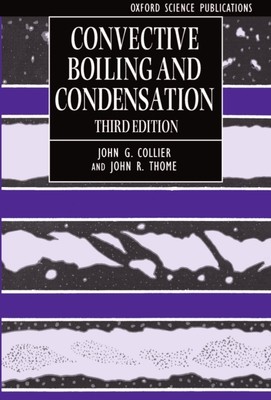
- We will send in 10–14 business days.
- Author: John G Collier
- Publisher: Clarendon Press
- ISBN-10: 0198562969
- ISBN-13: 9780198562962
- Format: 15.4 x 23 x 3.9 cm, softcover
- Language: English
- SAVE -10% with code: EXTRA
Reviews
Description
On its original publication in 1973, this book was the first reference for engineers to fully present the science of boiling and condensation. It dealt especially with the problems of estimating heat transfer rates and pressure drops, with particular attention to the occurrence of boiling and condensation in the presence of forced flows within pipes. The new third edition was written primarily for design and development engineers in the chemical process, power generation, and refrigeration industries, and is meant to be an aid in the design of heat exchangers. It covers recent advances and significantly broadens coverage to flows over tube bundles, with extensive new treatment of two-phase heat transfer regarding refrigerants and petrochemicals. Many new problems have been added at the end of each chapter to enhance the book's use as a text in advanced courses on two-phase flow and heat transfer. Instructors using the book as a course text may obtain full solutions to the
end-of-chapter problems by writing to: Science Marketing Dept., Oxford University Press, 198 Madison Avenue, New York, NY 10016 (please include school name and course identification), or by faxing (212) 726-6442.
EXTRA 10 % discount with code: EXTRA
The promotion ends in 17d.06:42:59
The discount code is valid when purchasing from 10 €. Discounts do not stack.
- Author: John G Collier
- Publisher: Clarendon Press
- ISBN-10: 0198562969
- ISBN-13: 9780198562962
- Format: 15.4 x 23 x 3.9 cm, softcover
- Language: English English
On its original publication in 1973, this book was the first reference for engineers to fully present the science of boiling and condensation. It dealt especially with the problems of estimating heat transfer rates and pressure drops, with particular attention to the occurrence of boiling and condensation in the presence of forced flows within pipes. The new third edition was written primarily for design and development engineers in the chemical process, power generation, and refrigeration industries, and is meant to be an aid in the design of heat exchangers. It covers recent advances and significantly broadens coverage to flows over tube bundles, with extensive new treatment of two-phase heat transfer regarding refrigerants and petrochemicals. Many new problems have been added at the end of each chapter to enhance the book's use as a text in advanced courses on two-phase flow and heat transfer. Instructors using the book as a course text may obtain full solutions to the
end-of-chapter problems by writing to: Science Marketing Dept., Oxford University Press, 198 Madison Avenue, New York, NY 10016 (please include school name and course identification), or by faxing (212) 726-6442.


Reviews